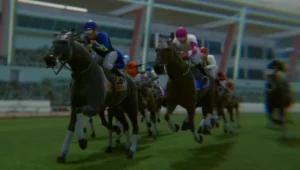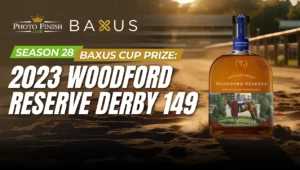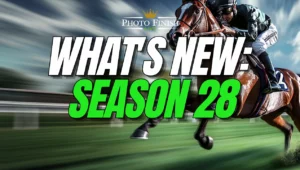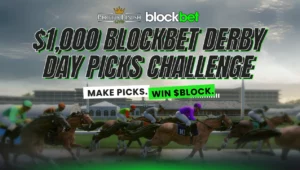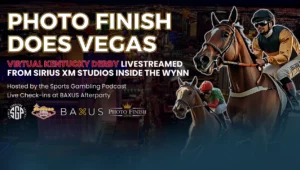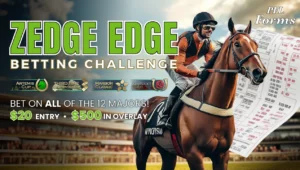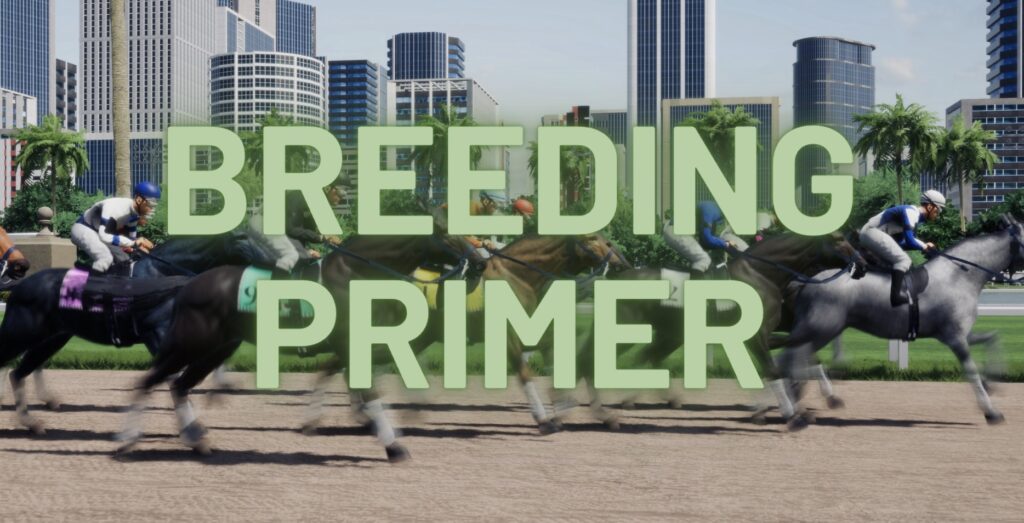
Hearken, thyself, for the season of Photo Finish™ LIVE procreation, draweth nigh!
For those of you unfamiliar, that loosely translates in Photo Finish™ speak to – prepare yourselves, it’s almost time to breed some virtual horses!
When Photo Finish™ LIVE exited BETA in late April for a newfound fully launched world, we all collectively circled with a red sharpie a big (and, then unknown) date on the calendar – Breeding Day.
With Breeding Day around the corner, the time has come to begin preppin’’ thyself for the arrival of the day we’ve all been waiting for.
Let’s run the gauntlet of Photo Finish™ breeding season factoids so when the breeding day arrives you’re ready to get to foal-making.
Breeding AMA: Tuesday, June 20, 8 p.m. EST
We know there will be questions. This being everyone’s first breeding rodeo, we anticipate players wanting to know more. Aware of this, and knowing every scenario would be hard to cover in a blog, we’ve decided the best way to tackle your inquiries is to cast a good old-fashioned AMA net over them all.
To best address any specific scenarios and/or breeding questions the community may have, Third Time Games CEO and Founder Ian Cummings will be taking part in an upcoming Breeding AMA dedicated solely to the subject of Photo Finish™ racehorse procreation.
The Season 3 Breeding AMA will take place on Tuesday, June 20, at 8 p.m. EST hosted by MJ Gaming on his ‘Across the Board’ Twitch stream.
In the meantime, the information below should put everyone in a good place to come up with questions that will fill in the gaps.
Breeding Window
The Season 3 breeding window will open on Monday, June 26, at 10:00 a.m. EST.
The Season 3 stud listing window closes on Sunday, July 2, at 9:30 a.m. EST.
The Season 3 breeding window will close on Monday, July 3, at 9:30 a.m. EST.
Breeding Price(s)
Breeding prices will always vary – especially according to the quality of stud you’re in the market for – but to add stability and a beginning point Third Time Games has set a ‘Foal Floor,’ or if you like saying things in a less fun way, minimum breeding prices.
Below are both In-house and public fees to consider before beginning your breeding journey.
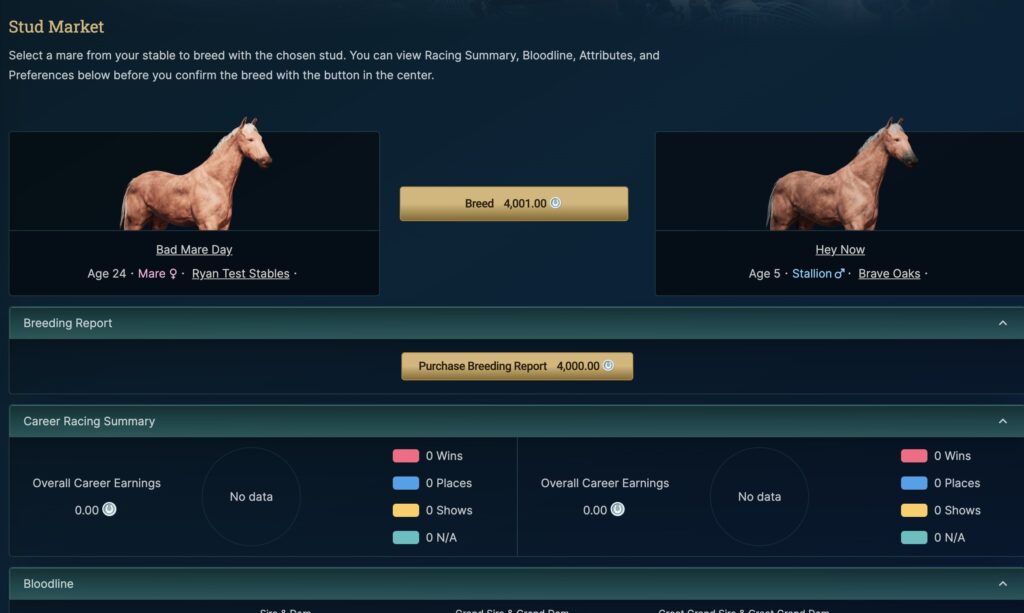
In-House Breeding Fee:
- Owners have the option to list their stud PRIVATELY, where only horses within their own stable can see them and breed with them. If this is you, there will be a minimum fee of 8000 DERBY ($100), with no extra service fees. If you don’t mind your stud being listed publicly, then…
Public Breeding Fee:
- If you decide to breed your horse with a stud owned by someone else (public), or maybe even your own publicly listed stud, the stud owner sets the breeding fee. The minimum Stud Fee is 4000 DERBY ($50).
- In addition to the breeding fees set by stud owners, a 20% breeding service fee will be added to the total cost.
Important Reminders about Breeding Fees:
- 100% of the breeding fees and marketplace fees paid in DERBY currency will be reserved to support the race purse.
There are no additional fees from the Third Time platform, and Third Time will toss every penny collected from breeding fees back into the support of the racing ecosystem as part of the ‘‘Growth Phase’ plan previously outlined.
TL;DR: All breeding fees head back into the racing ecosystem.
Stud Listing Restrictions
Unlike real life, one of the things we have to protect against in our game is exploits! We of course want players to be able to adjust the prices of their studs as well as pull down listings from the market, but allowing this freely opens up avenues for players to ‘beat the system’. These are the restrictions in place:
- Once listed on the stud market, a stud cannot be removed from studding until the following season.
- Once listed on the stud market, a stud’s Stud Fee can only be edited once every 12 hours.
- Though the breeding window ends on Monday morning, 30 minutes before the season rolls over, studs have to be listed 24 hours before this point.
Breeding Mares
Mares play a vital role in the breeding process. Here are some important points to consider regarding mares and their breeding capabilities:
- Breeding Limit: Mares may breed only once per season, allowing for a controlled number of offspring each year. This, of course, is obviously meant to stay in line with what would occur in real life.
- Foal Production: A bred mare produces a foal at the beginning of the next game season. This gives breeders time to prepare for the arrival of the new foal and make any necessary arrangements.
- Breeding Partner Selection: Mares have the flexibility to choose their breeding partners at any time during the breeding season. This freedom enables them to select a suitable stud based on factors such as bloodline, traits, and compatibility.
Breeding Studs
Studs, the male counterparts to mares, also have specific guidelines for breeding. Here’s what you need to know about studs and their role in the breeding process:
- Breeding Limit: Studs may breed up to 35 times per season. Once a stud reaches this limit, it can no longer participate in breeding for the remainder of the season. This restriction helps regulate the number of offspring each stud produces.
Breeders will have the option to select studs from the market or use their own owned studs for breeding purposes. This flexibility provides breeders with a range of choices when it comes to finding the ideal stud for their mare.
From the perspective of the owner of a stud, deciding on whether to open your horse up to other players for the maximum 35 breeds or to keep all that stud goodness to yourself, is a major point of strategy and something that will be a pivotal breeding decision in every player’s journey along the way.
Sharing in the stud barn is caring, until all those foals grow up to be monsters on the track!
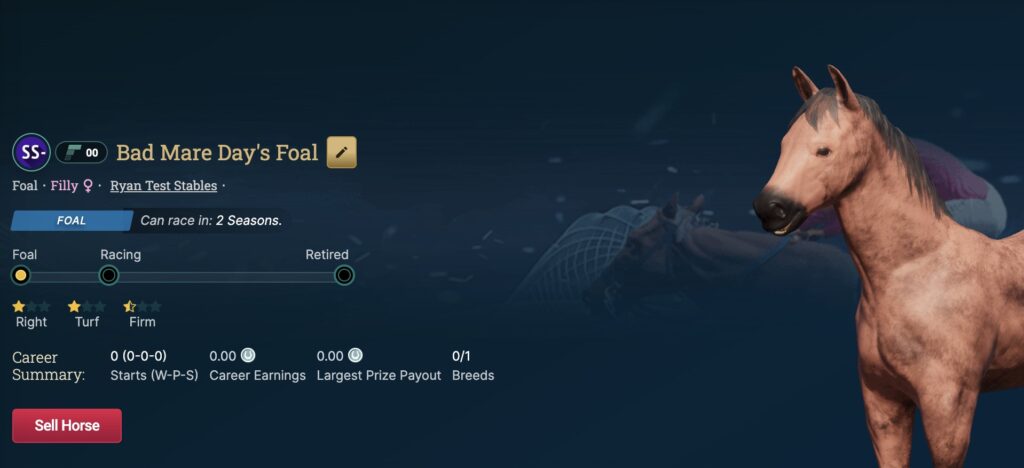
Impact of Inbreeding
We suggest against inbreeding. But if you do, it’s important to know the impact of smashing two related partners together in the breeding barn will have on the foal.
Players can expect inbreeding to carry significant penalties. Just as inbreeding would impact the genetics of a real horse, the same applies at Photo Finish™.
When two horses mate, their bloodlines are examined back to their great-grandparents (doesn’t sound very romantic, but that’s genetics!).
When two horses have a common great-grandparent, things get weird, and in the end, inbreeding will simply hurt the resulting foal’s ability, both in terms of racing and breeding performance.
In the process of breeding horses, every aspect of the racehorse’s DNA, known as genetic traits, has the potential to get downgraded. The foal will likely experience a downgrade by one level (for instance, from A to A-) in racing capabilities if you inbreed.
So don’t inbreed. Inbreeding is bad. Inbreeding makes bad horses, probably.
*Reminder: For those thinking about the long-term of their stable, remember this – if you are breeding 100 different Fillies (female horses) with the same Stud (male horse), it means there are now 100 siblings who cannot mate with each other without incurring significant penalties.
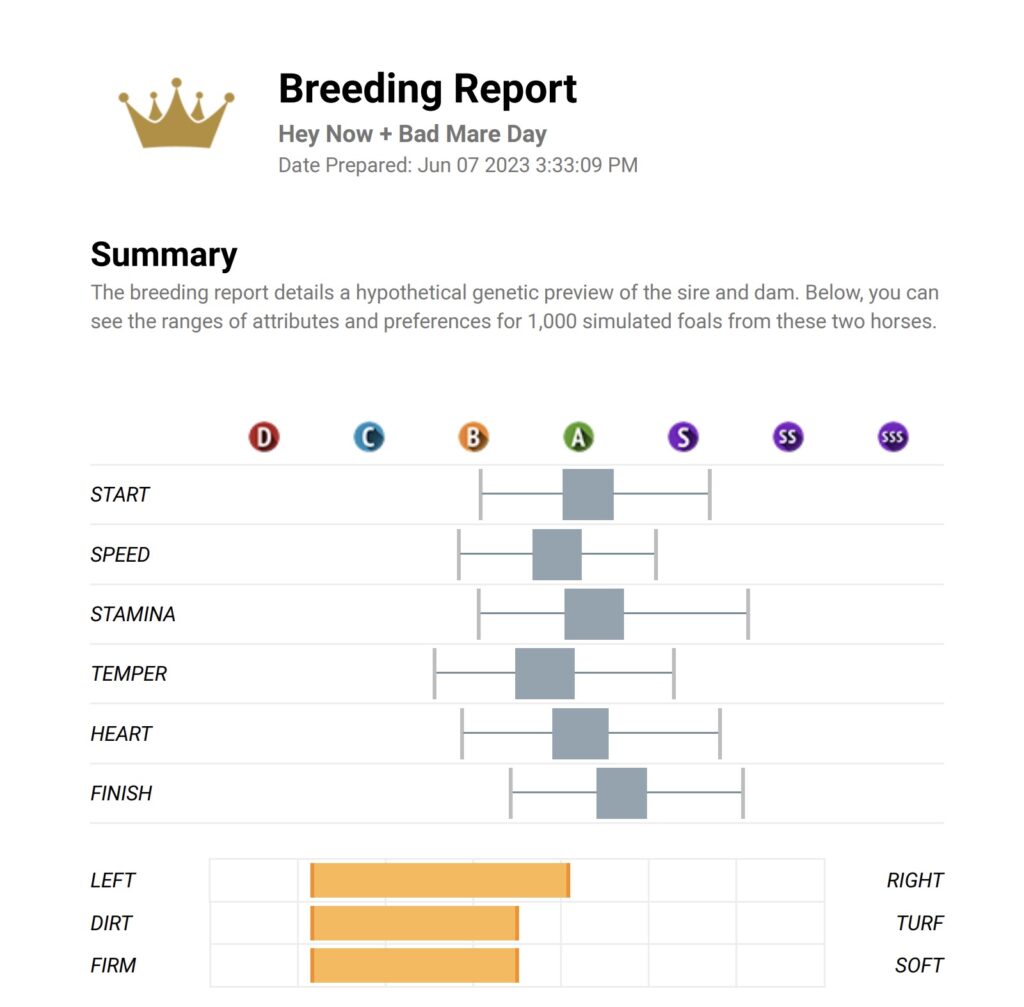
About Breeding Reports
Finding the right partner in the breeding barn can be challenging, which is why Photo Finish™ created a valuable tool called “Breeding Report” that allows you to preview a hypothetical breeding outcome before making any final decisions.
The Breeding Report provides powerful insights and information that can help you make informed choices before breeding two horses, thus alleviating some of the anxiety that goes into breeding decisions by giving you a glimpse into what the resulting foal may be like.
TL;DR: Breeding Reports cut out much of the guesswork when it comes to breeding, but do not guarantee what will happen. Think of Breeding Reports as a weather forecast – usually on point, because of science, and math, but people only remember them when they’re wrong.
Breeding Report Fees
- Breeding reports are available to purchase within the breeding barn for 4,000 $DERBY. Go crazy. There is no limit to how many you can buy.
- Membership Perks: PFJC EXEC (Photo Finish™ Jockey Club) members will receive ten complimentary breeding reports for each mare they own during the breeding season.
TL;DR: Breeding reports consider multiple factors such as bloodline, traits, and genetic predispositions. The report also provides an overview of the potential strengths and weaknesses of the resulting foal, allowing breeders to make more informed decisions.
Breeding Basics
Just as in real-world horse breeding, pairing Photo Finish™ horses is an intricate process that requires careful consideration of various factors to ensure successful outcomes.
No matter if you’re breeding an S or B-grade horse, finding a suitable breeding partner is crucial to achieving your desired traits.
To help prepare you for this process we’ve compiled some effective strategies for finding the right breeding partner, understanding the genetic variations between sibling horses, and addressing the challenges of breeding for opposite preferences.
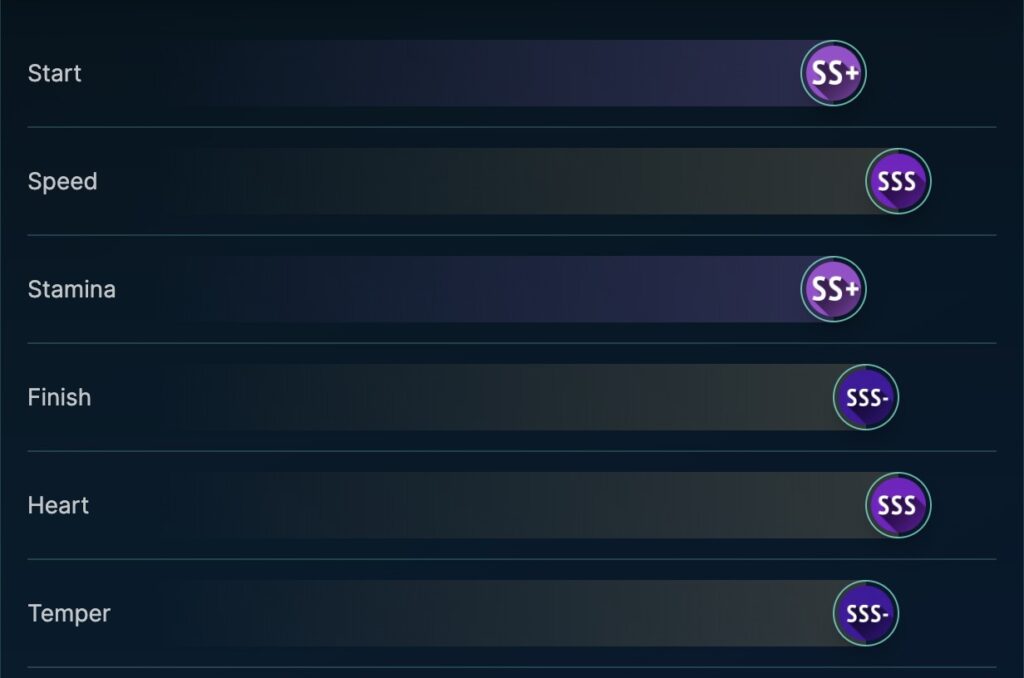
Define Desired Traits
We’ve all been there – you walk into a store with a purpose, but as soon as you get 10 steps inside you are completely blanked on what you came for and end up wandering the aisles in search of a reminder of what it was you came there for.
Breeding a Photo Finish™ horse can be exactly that overwhelming if you don’t come into the breeding barn with a game plan.
Before embarking on the search for a breeding partner, it’s essential to identify the specific attributes you wish to breed for. Narrowing down your focus to two or three key traits helps streamline your breeding goals and maximize the chances of success.
Example:
You’ve got a mare that’s a strong sprinter, but her early speed is lacking. When selecting a breeding partner you have two choices: Look to heighten what she is good at by breeding with a stud that also sprints well, or look for a stud with high early speed boosts.
The strategy within the breeding barn is endless. Decisions you make along the way can either lead to generations of strong foals, or those that require more fine-tuning.
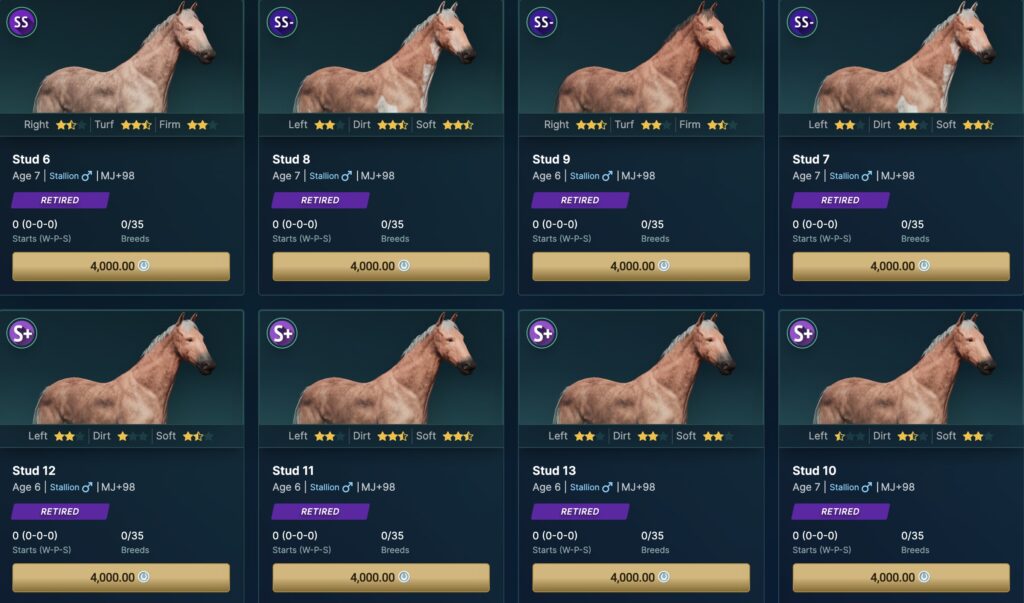
Partner Selection
Once you have determined the specific traits you are looking for, the next step is to find a suitable partner for breeding. A good starting point is to search for horses that already possess the desired traits and ideally come from a consistent lineage that consistently exhibits those attributes.
When selecting a breeding barn partner, it’s important to remember – the more consistent the lineage of the potential parent, the higher the likelihood of passing on those desired traits to the offspring.
Understanding Sibling Differences
Sibling horses can exhibit significant variations despite having the same parents. This variation arises from the vast number of genes horses possess.
Each parent passes on only 50% of their genes, allowing for genetic recombination and the potential emergence of new combinations not present in the parents.
For example, if the stallion has a specific set of genes and the mare has a different set of genes, the foal may inherit a unique combination of genes that’s distinct from both parents – just like in real life. What the combination will be is a bit up to chance, but always a result of what the parents have passed down.
Breeding for Opposite Preferences
Looking to zig and zag? No problem – breeding a horse with an opposite preference, such as transitioning from dirt to turf or right to left, poses a challenge – because horses tend to pass on their preferences to their offspring – but the right combination of partners will do the job.
To achieve the desired preference change, you’ll need to find a breeding partner with a strong inclination towards the opposite direction. This may take several generations of selective breeding before the desired preference becomes more prominent, but it’s possible to achieve.
The Role of Genetics in Breeding
It is crucial to understand that breeding in Photo Finish™ LIVE follows genetic principles, adhering to the same rules governing real-life genetic inheritance.
Each parent contributes half of their genes, which then combine to determine the traits expressed in the foal. Therefore, the only way to increase the chances of producing a good breed is by selecting breeding partners with favorable genes.
There are no attributes, preferences, traits, or items that can alter the genetic pairing process or influence the outcome of breeding. A successful breeding outcome will be the result of good old-fashioned hard work, research, and dedication.
More Breeding Resources
Breeding is undoubtedly a core strategy within the Photo Finish™ game. Utilizing true-to-life genetics makes breeding as realistic as it gets, but also, at times, as complex (see: challenging) as it gets!
Here is a little light reading that will help players better understand what goes into a successful breeding strategy:
PFL Inside Track – Part 1 – Genes & Matches

